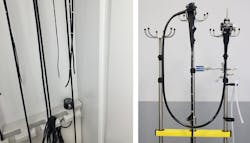Whether you’re involved in an athletic competition, business project, charitable event, clinical procedure, financial exercise or operational task, including sterile processing, supply chain or surgical workflow, the mantra remains the same: Start fresh; work accurately, effectively and efficiently; and of course, finish strong.
In the reprocessing of endoscopes and other endoscopic equipment, crossing the finish line typically translates to aerating, drying and storing sterile devices so they’re ready for use in the surgical suite.
Because these last steps before transporting the sterile devices to the operating room remains so important, Healthcare Purchasing News asked more than a dozen sterile processing subject matter experts for useful tips on completing these last tasks properly. Here’s what they shared.
“Ensuring the staff and facility have adequate storage and reprocessing space is critical. Hospitals can invest in large-scale, specially designed storage areas. Additionally, hospitals can evaluate using sterile, single-use endoscopes for procedures – freeing up or reducing demand for space in SPD or point-of-care to store excessive volumes of flexible endoscopes. One benefit of the single-use endoscope is the ability to reclaim crowded, valuable hospital space for more efficient use. Single-use devices also eliminate the potential for cross-contamination when properly utilized. “
- “Use external drying devices post-endoscope removal from the AER.
- “Drying cabinets offer a drying option for endoscopes both externally and internally.
- “Existing conventional cabinets may be retrofitted with cabinet filters as well as channel drying hook-ups.”
Minerva Loran, Clinical Choice LLC
“Effective aeration of an endoscope is best achieved by a system that connects to the Air/Water, Suction and Auxiliary Channels. Endoscopes can be aerated prior to or during storage. Check with your aeration or endoscope cabinet company as to their recommended aeration times.
“Look for endoscope storage cabinets that meet current and future society guidelines. Cabinets with significant 24/7 HEPA-filtered air flow, removable drip trays and abilities to upgrade the cradles and drying system will protect your endoscopes and your capital investment.”
- “Allow and take time for thorough and proper drying. The drying cycle of many AERs and simple alcohol flushes do not produce completely dry endoscopes for use or for storage.
- “Invest in air. Whether that is adjustable instrument air at a workstation or filtered forced-air drying cabinets. Both will produce far better results than syringe flushing or hang drying. Both of which have been proven far less effective than their forced air alternatives.
- “Understand drying’s importance to the process. The wet environment inside of an improperly dried endoscope is the perfect breeding ground for water-loving bacteria. Thoroughly drying endoscopes between uses and before storage will remove that risk from the process.”
“Store endoscopes in an automated drying cabinet. Research has shown that storage using an automated drying cabinet, which allows each channel to be connected to a constant flow of filtered, compressed air along with circulating air to enhance surface drying, is the best for eradicating moisture. (Perumpail et al. “Endoscope reprocessing: Comparison of drying effectiveness and microbial levels with an automated drying and storage cabinet with forced filtered air and a standard storage cabinet.” AJIC 2019)
“Dry endoscopes for a minimum of 10 minutes using forced, HEPA-filtered air. If your facility does not have access to automated drying cabinets, and you use vertical hanging to store, manually drying your scope for about 10 minutes before hanging is the minimum required for eradicating potentially dangerous residual moisture. (Barakat, et Al., “Comparison of automated and manual drying in the elimination of residual endoscope working channel fluid after reprocessing” Gastroinstest Endosc 2019)
“Conduct a risk assessment at your facility to determine a safe/proper storage time between reprocessing. Assuming that high-level disinfection/sterilization has occurred according to the manufacturer’s instructions for use (IFU), and that the scopes are stored in a closed environment with all of the valves and accessories removed, we see a mix of recommendations for how long until the scopes need to be reprocessed again. The Association for Professionals in Infection Control and Epidemiology (APIC) suggests a hang time of seven days, and after that seventh day the scope should be reprocessed. The multi-society guideline published in 2016 suggests that reprocessing within 21 days is safe. SGNA supports a seven-day storage window as well. AORN and AAMI both agree, but give a vague recommendation that each facility perform a risk assessment to determine proper storage time.
“If you have an automated drying cabinet that forces a constant flow of air through your scope, you may be able to extend the time up to 30 days or however long the IFU calls for. The lack of clarity between the standards is a huge concern because if you are hanging your scopes, there will absolutely be residual moisture left over. Gather up your facility’s key players (clinicians who perform endoscopy, reprocessing personnel, infection preventionists, quality/risk management team and administration). Test how many of your ‘patient-ready’ scopes have microbial contamination. Test for residual moisture in your scopes. Evaluate the real cost of resources and personnel it takes to adequately manually dry and endoscope, or the real cost of constant reprocessing due to short hang times.”
Melissa Kubach, Mobile Instrument Service & Repair
“If the facility does not have internal channel drying capabilities within their cabinet, they could utilize a drying box unit to facilitate drying prior to storage.
“Cabinet upgrade retrofits are available for multiple manufacturers’ existing cabinets to add aeration and drying capabilities.
“Cabinets need to be maintained for cleanliness and inspected for chips or damage. There are numerous choices of available cabinets with built-in positive pressure or filtered circulated air. There is one cautionary note when choosing one of these options. Historically, drying has not been heavy with oversight. Many of the cabinet options contain tubing with permanent metal end fittings that do not have clear cleaning instructions. Some [companies] may say wipe down with use, then high-level disinfect weekly. All trends lead to restricting shared connections between endoscopes once cleaned without the attachments being, at minimum, high-level disinfected. Currently, these reusable cabinet hook-ups are not validated to be run in any AER. It would be unfortunate to find out down the line that the reusable tubing and connectors need to be processed with each use as well. Only time will tell.
In a nutshell, drying of endoscopes externally and internally is necessary, and it should involve at minimum safe filtered air sources, clean connections and storage cabinets that either facilitate internal drying or promote the sustaining conditions for endoscopes dried prior to storage.”
- “Storage cabinets should be located in a designated room when possible, or at minimum in low-traffic areas. Endoscope storage cabinets should not be located in procedure rooms.
- “Preferred storage for endoscopes is a drying cabinet that dries both the outside of the endoscope as well as endoscope channels. Recommended channel air options for drying cabinets include nitrogen, instrument air, medical air or at minimum, HEPA-filtered air.
- “If a drying cabinet is not available, a ventilated storage cabinet may be used that features HEPA-filtered air, a built-in fan and positive pressure inside the cabinet.
- “All cabinets should include doors that can be closed and secured, hangers to safely hold the endoscope, and adequate space to ensure scopes hang freely without contacting other scopes or any surface of the cabinet (top, sides or bottom).
- “Vertical storage is preferred to enable endoscope channels to drain and maintain the shape integrity of the scope.”
“First, you should consult the endoscope manufacturer’s IFU. Using a platform like oneSOURCE makes it incredibly easy to access the most updated IFUs and preventive maintenance documents needed to effectively decontaminate and sterilize. It may have instructions for how to perform these tasks.
“Next, you should consult current standards/guidelines from AAMI, AORN and SGNA. For example, a controversial topic for endoscopes has been ‘hang time,’ which is the amount of time a scope can be stored before it should be reprocessed. Depending on the standard or guideline, you may get different guidance for hang time. Then you should discuss the proposed process and/or gaps with Infection Prevention and possibly the department(s) where the scopes will be stored. You may find the storage requirements cannot be met in certain areas, due to space, resources, etc.
Next, you should perform a risk assessment that incorporates and documents all the requirements, decisions and outcomes.
Last, update policies, training materials and competencies to ensure that the process is followed correctly.”
“Be sure that all flexible endoscopes are hung in a vertical position only without any bends in the insertion tube or umbilical cable. Traps create areas for water to remain and could allow bacteria to grow.
“New horizontal drying cabinets are a great way to store flexible endoscopes for up to 30 days. These cabinets include aeration to keep the endoscopes clean and dry.
“Be sure that no matter what type of storage cabinet you use for high-level disinfection (HLD) flexible endoscopes that you have, gloves available for the handling of the devices. Flexible endoscopes should never be ‘bare handed’ when transporting them.”
- Outlook Endoscopy: What’s next for endoscope reprocessing and device design?
- Looking ahead at endoscope reprocessing quality performance
- Techniques and tips for aeration, drying and storage
- Why ergonomics should not be over- looked
- Advance SPD to include higher-paid specialist teams
- The true colors of hydrogen peroxide sterilization chemical indicator strips
- Periscope: Color-coded standard needed for hydrogen peroxide sterilization indicator strips
- Endoscope Care in 2020 and beyond
About the Author
Rick Dana Barlow
Senior Editor
Rick Dana Barlow is Senior Editor for Healthcare Purchasing News, an Endeavor Business Media publication. He can be reached at [email protected].








